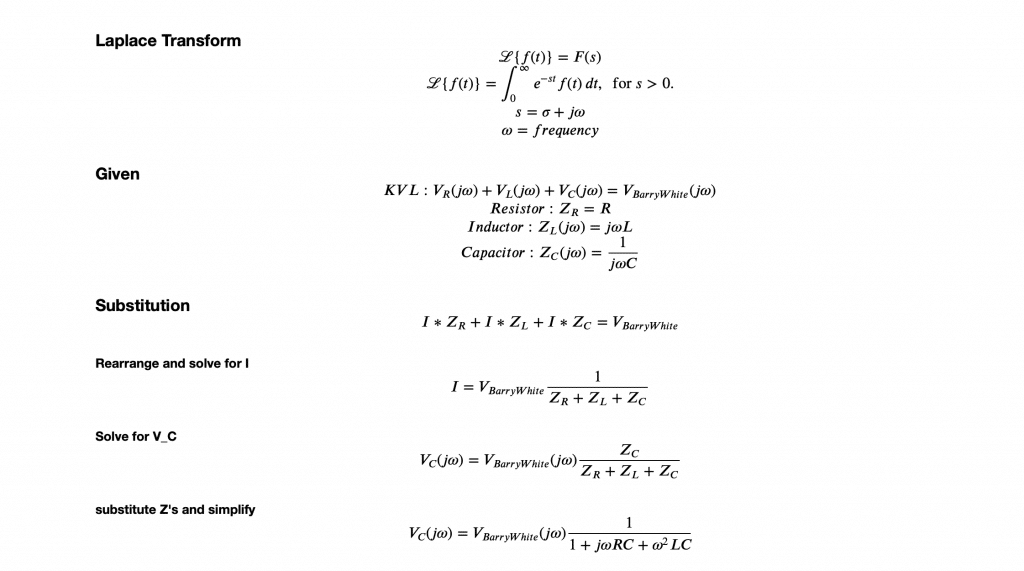
Intro
There are enormous amounts of time-series data continuously generated throughout the world, including the heart rate monitor on the Apple watch, the thermostat in your home, or a self-driving car continuously digesting data about the environment coming at it at high speed. Time-series data is data that changes over time. Time is not just a metric in the data but the primary index. Besides the technical challenges related to the ingestion and storage of time-series data, there are new engineering challenges that have emerged for machine learning (ML) and deep learning (DL) algorithms processing time-series data.
Other Disciplines
Before diving into ML/DL, I’d like to explore the time-series data from an Electrical Engineering background and how the tools used to analyze electrical circuits that can be adapted to time-series ML/DL analysis.

Electrical Engineering has a long history of analyzing time-series data. They don’t call it time-series data. Most engineers call it voltage or current or signal in general — for example, an electrical circuit that models a music player, a filter, and a speaker.

When you find yourself in a precarious situation, where you need the dulcet tones of Barry White to save a town from the attack of the snakes, you might need such a setup. The sound from the music player is filtered for lower frequency sounds and fed into a subwoofer. Barry White’s voice coming out of the music player is the time-series data, the change in signal over time. Here the engineering challenge is to build a filter that will filter out high-frequency sounds and only send low-frequency sound to the subwoofer.

I will use a second-order RLC low pass filter here for analysis. It only has a few circuit components, and it shows the complexity of classic analysis.
Our goal here is to find the voltage across the capacitor (C), which drives the subwoofer and select the values for the resistor (R), inductor (L), and C. The values have to be selected to suppress higher frequency sounds and pass through the lower frequency sounds. Also, since the goal here is not to get lost in the mathematical weeds, I’ll state the initial analysis with a lot of assumptions.

We just started the analysis and we are faced with this complicated second-order derivative equation. It is not clear how this relates to the lower frequencies and what the R, L, and C values should be. I’m going to walk away from that, and maybe show a full analysis for the curious ones in another post, and jump straight into frequency analysis.
Transform The Problem
Often in mathematics and engineering, when a problem is complicated to solve, you try to visualize it in a different domain. For our toy example, I’m looking at filtering frequencies, and we can try to move to the frequency domain and see if that helps. In fact, most of such filter circuit analysis is done in the frequency-domain. The time-domain analysis that I’ve called classic here is complex and not that intuitive. Moving to frequency-domain (s-domain more preciously) comes with some nice benefits here. We use something called “Laplace Transform” to convert the calculus to algebra. Besides simplifying the math here from calculus to algebra, we are dealing with frequencies that directly relate to the problem of creating a low-frequency filter.

With a lot of assumptions and looking at only at the steady state, using Laplace transforms and algebra instead of calculus makes the analysis easier. The solution is in terms of frequencies. That helps with intuition for what frequencies would work with what component configuration, the values for R, L, and C.
Conclusion
We are amid a time-series data tsunami. The usual ML analysis does not apply, or it is too complicated to apply to time-series data. Transforming the data into another domain will help with data analysis.
At Translucent, we have started experimenting with different data ingestion schemes, testing different time-series databases, and testing different approaches to time-series ML/DL analysis. We are applying the new ML/DL analysis to https://www.tekstackhealth.com/
December 29th, 2019
by Patryk Golabek in Applied Machine Learning
See more:
December 10th, 2021
Cloud Composer – Terraform Deployment by Patryk Golabek in Data-Driven, Technology
December 2nd, 2021
Provision Kubernetes: Securing Virtual MachinesAugust 6th, 2023
The Critical Need for Application Modernization in SMEs